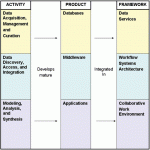The plan for cyberinfrastructure (CI) support for future LTER research has just been released as part of the "Decadal Science Plan for LTER". The CI strategic plan was commissioned as part of the overall LTER Network planning process with the express purpose of identifying CI critical to meeting LTER's research and education objectives. As part of this process, the CI planners convened a large and diverse group of information technology (IT) professionals from science and technology centers, large IT development projects, and national observatory initiatives.
In a series of meetings, this group identified areas where improvements in cyberinfrastructure were necessary. The LTER CI planners articulated the input from this group into specific suggestions in areas such as data management, data integration, and modeling, as well as crosscutting issues like system architecture, collaborative environments, strategic CI partnerships, workforce training, education, and outreach activities (see accompanying box for details). The plan then went through a number of iterations and reviews by the LTER National Advisory Board (NAB) and the Network Information System Advisory Committee (NISAC) before going out for comment from the larger community.
Trying to predict and plan for technology 10 years out is always tricky. It's even trickier if you're trying to anticipate the support needed for new and innovative scientific studies that haven't yet been articulated. The LTER cyberinfrastructure planners confront these issues by focusing on advanced capabilities and needed functionality. The authors and contributors, knowing the dangers of specifying exact technologies too far into the future, have opted for building capacity with an understanding that exact implementations will be specified and planned as the "Decadal Plan" progresses.
The LTER program will draw heavily on existing strengths and partnerships in building this new cyberinfrastructure. These strengths include the availability of existing long-term data and Network-level derived data products, use of community standards for metadata, policies for sharing data, broad ecoinformatics expertise, active informatics research, and the LTER Network Office serving as the focal point for development efforts. Existing partnerships with the National Center for Ecological Analysis and Synthesis (NCEAS), the San Diego Supercomputer Center (SDSC), and the National Center for Supercomputer Applications (NCSA) are collaborative strengths, as are new and growing associations with emerging observatory platforms such as the National Ecological Observatory Network (NEON), the Ocean Observatory Initiative (OOI), and the Water and Environmental Research Systems (WATERS) Network.
A survey of LTER sites administered twice during the planning period also identified several hurdles that need to be cleared before implementing the new wide-reaching research plan. Critical issues that require immediate attention include uneven information management and IT expertise among sites; diverse forms of data and methods for collecting and managing data; wide variations in internet connectivity (particularly at field sites); and inconsistent access to collaboration technologies. Recommendations in the CI plan reflect the critical nature of these issues. For example, getting additional technical resources to the sites is stated as one of the highest priority cyberinfrastructure needs. Meeting these critical needs will no doubt be foremost in the minds of the Network Information System Advisory committee (NISAC) when they begin to address implementing the CI strategic plan this fall. The NISAC committee, currently co-chaired by Deb Peters (Jornada LTER) and Wade Sheldon (Georgia Coastal LTER), will be the key governance body addressing implementation of the CI plan. The committee is made up of five site principal investigators, four information managers, and five Network Office representatives.
To build the capacity called for in the CI strategic plan represents a significant new investment in people and information technology for LTER. These investments translate into activities that will be challenging to implement but will no doubt be the first step towards achieving a fully integrated research network capable of sweeping advances in ecological understanding.
For further reading you can find the "Decadal Plan for LTER" at www.lternet.edu/decadalplan/
Six strategic CI strategic plan initiatives to support new science activities
- Build community-based services and a service-oriented architecture (SOA): A scalable, community-based, service-oriented architecture will provide data services to ensure secure and efficient access to data stored in site data repositories, as well as provide computational services for numerically demanding analyses and models and for large-scale multi-site experiments that include sensor networks, satellite sensors, and high performance computing.
- Build CI capacity to increase data acquisition, management, and curation at the site level: Near-term goals for increasing LTER sites' capacity for collecting high-quality data and participating in Network-wide experiments, integration, modeling, and synthesis activities will require significant enhancements to staffing and technology.
- Build CI capacity to increase data discovery, access, and integration: Advances in data integration require the development of innovative prototype systems utilizing data warehousing and distributed query systems technologies, linked to research in applying knowledge representation and semantic mediation approaches to harmonize heterogeneous data.
- Build CI capacity to increase modeling and analysis activities: Facilitating and coordinating LTER Network-wide analysis and modeling activities aimed at understanding and forecasting changes in regional, continental and global dynamics of social-ecological systems will require significant investment in computing services, software development, and staffing. This effort will require developing scalable computing resources, advanced analytical environments such as scientific workflow systems, and a community-based repository for archiving model code.
- Build capacity to increase collaboration: Collaborative work environments allow scientists residing in different locations to analyze, discuss, annotate, and view data using collaborative analytical tools and video teleconferencing. LTER researchers need access to these tools at both central and remote locations.
- Integrate cyberinfrastructure into social-ecological research, education, and training: Integration of new cyberinfrastructure including advanced tools for analysis and synthesis within the LTER research process will require linking centrally-developed training, education and outreach programs to other training resources that can be remotely accessed by scientists, students, and technicians.

 Enlarge this image
Enlarge this image